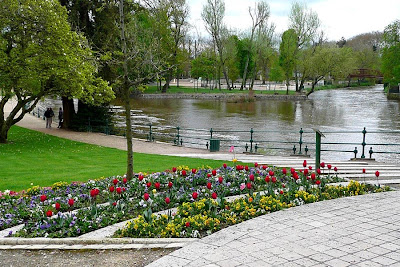on a Monday afternoon — main street in Romo
The Michelin green guide says that Romorantin is un peu, par sa position géographique, le nombril d'une certain France profonde, rurale et traditionnelle — Romorantin is, "in a certain sense, because of its geographical location, the bellybutton of a kind of 'deepest' France, rural and traditional." From my point of view, that is a very good thing.
Romorantin sits on the banks of the Sauldre River, and there are several islands in the river at the center of town. Some of them are developed and at least one is a big park. The Sauldre is a tributary of the Cher River, which runs through Saint-Aignan, Chenonceaux, and the city of Tours.
 Water levels in the Sauldre and the Cher are very high, after
Water levels in the Sauldre and the Cher are very high, afterall the rain we've had in France this year. Notice the modern
apartment building on the banks of the river.
Romo is a small town in the middle of a big forest full of lakes and fields. A lot of people from the Paris area come to the Sologne, which covers an area of 2,000 sq. mi., for vacations and to enjoy the feeling of country and "wilderness" here. Now there's an autoroute linking Paris to Romorantin, and the drive takes between 2½ and 3½ hours, depending on traffic. Orléans is about an hour north of Romo, and Bourges, another good-size city, is less than an hour southeast.
Romo has a long history, of course. The Sologne was occupied by the Romans, as archeological digs have shown. It became Christian in the 4th century of our era. As the Roman Empire collapsed, there were "invasions" of "barbarians" from Eastern Europe. Later, the counts of Blois and Bourges, and the dukes of Orléans, controlled parts of the territory. The villages of Romorantin and Lanthenay existed as long as 1200 years ago.
Five hundred years ago, François Ier, the French king who built Chambord, expanded Fontainebleau, and brought the Italian Renaissance to France, spent his childhood and youth in Romo. His queen, Claude de France, was born in the town.
Young king François had great plans for Romorantin, for which he had great affection. He asked Leonardo da Vinci, who spent the last years of his life in nearby Amboise and Blois, to design a château and elaborate gardens for the queen mother, Louise.
Unfortunately, an outbreak of plague prevented the realization of the king's projects. Instead of redesigning Romorantin, the Renaissance king turned his attention to the big "hunting lodge" at Chambord. And Romorantin and the Sologne languished — isolated, rural, and undeveloped.








i am fascinated as you may have guessed by la france profonde. is georges sand (in english, alas, since it's the only thing i can read) really the best novelist of the same?
ReplyDeleterecipe books, strangely enough, including Madeleine Kamman's When French Women Cook, have given me an excellent whiff of what it could be like out there. in there. down there.
Many thanks for the beautiful photos and fascinating historical notes.
ReplyDeleteFrom Oxford Good Fiction Guide:
"Contemporary novelist Sylvie Germain has captured acutely the timeless qualities of life in what's called LA FRANCE PROFONDE; the wild, mysterious centre, a harsh region of mountains and forests. Try DAYS OF ANGER (1988) which mixes melodrama and a French sort of magic realism to convey themes of murder and revenge."
See Vikipedia for more on this writer, and contemporary French novelists.Bonne chance!
For me it's Balzac, again, and again, and again. His people are part of my world, as real as the people I meet everyday.
I wish I could come up with a good answer your question, PJ. I would think Sand and Balzac would both give a good view of la France profonde, but a 19th-century view. Same with Maupassant. I don't know what writer would give a current view.
ReplyDeleteThanks for the reference to Madeleine Kamman's book When French Women Cook; the only one I have is In Madeleine's Kitchen. I'll look for the other one, which sounds more interesting.
thank you both for the reccies, balzac, germaine, maupassant -- i've just ordered this 20th c non fic history from amazon....
ReplyDeletehttp://www.amazon.com/Discovery-France-Historical-Geography-Revolution/dp/0393059731/ref=sr_1_1?ie=UTF8&s=books&qid=1209232657&sr=1-1....
...and am trying to finish off the brilliant and slightly sentimental/reptilian ladies' paradise, which is very important in -- oh, nevermind. certainly not la france profonde.